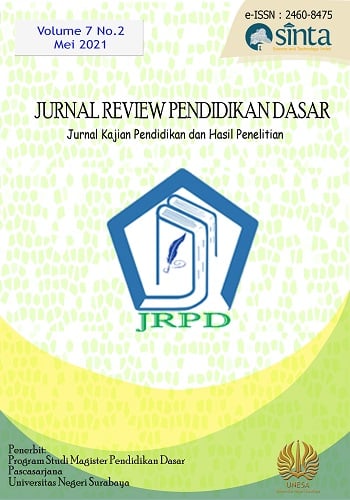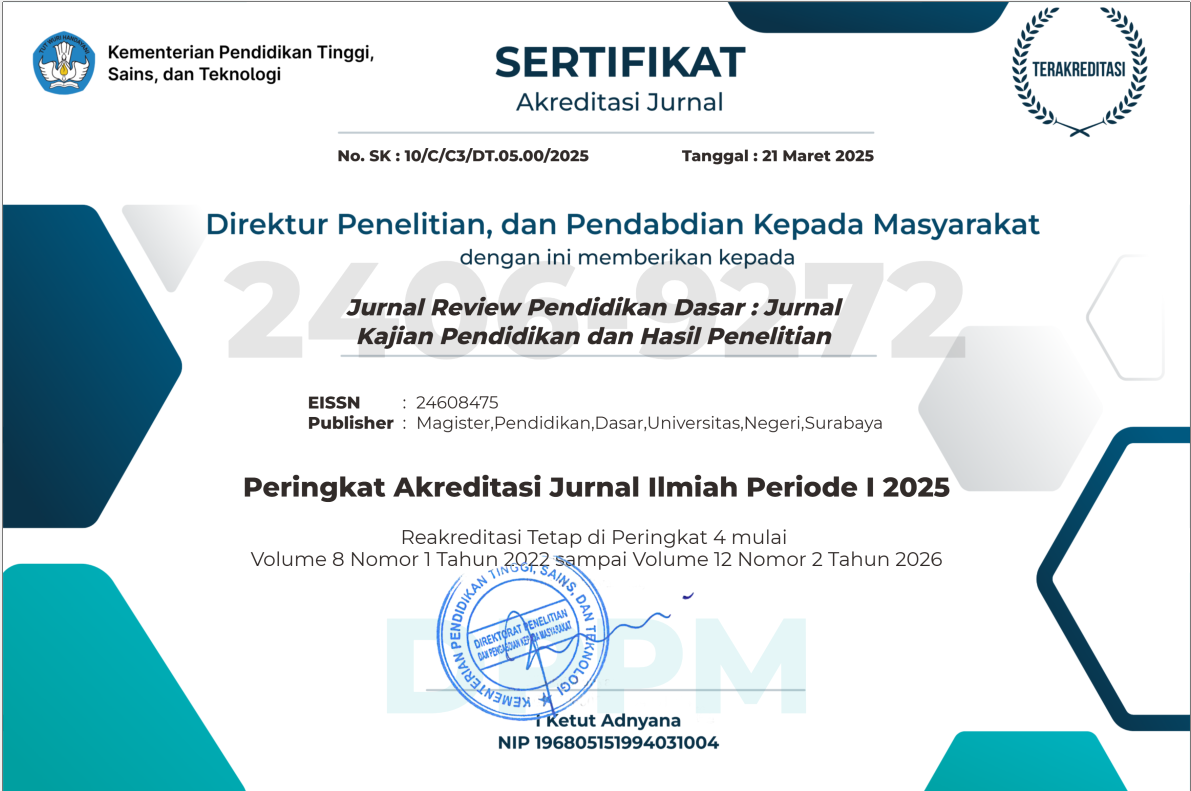PERILAKU AWARENESS SISWA KELAS V SD DALAM MEMBACA PEMAHAMAN TEKS NONFIKSI
DOI:
https://doi.org/10.26740/jrpd.v7n2.p74-80Abstract
The purpose of this study was to describe awareness behavior using a descriptive-qualitative approach in the first semester of class VA and VB, with a total of 30 students (16 boys and 14 girls). The data collection process was given a reading comprehension test (TMP), a behavioral awareness test (TPA) 1 which was seen from the test scores of Indonesian Language Subjects for each student. The results of the analysis of TMP, TPA 1, TPA 2 and the Indonesian language test scores were categorized into three abilities, namely high, medium, and low abilities. The three categories are represented by a communicative subject. It was concluded that the SBT awareness behavior in reading comprehension of non-fiction texts fulfilled the five indicators, namely P1, P2, P3, P4 and E1. SBS also fulfills the five indicators, but in implementation there are still errors in the P2 and P3 indicators so that they affect the answers. The SBR ignores indicators P4 and E1, and is less than optimal and does not understand indicators P1, P2, and P3.
Keywords: behavior awareness, non-fictional, text reading comprehension
ABSTRAK
Tujuan penelitian ini adalah mendeskripsikan perilaku awareness menggunakan pendekatan deskriptif-kualitatif di kelas VA dan VB semester I, dengan jumlah kesuluruhan siswa 30 orang (16 laki-laki dan 14 perempuan). Proses pengambilan data diberikan tes membaca pemahaman (TMP), tes perilaku awareness (TPA) 1 yang dilihat dari nilai ulangan Mata Pelajaran Bahasa Indonesia tiap siswa. Hasil analisis TMP, TPA 1, TPA 2 dan nilai ulangan Bahasa Indonesia dikategorikan dalam tiga kemampuan, yakni kemampuan tinggi, sedang, dan rendah. Ketiga kategori itu diwakili salah satu subjek yang komunikatif. Disimpulkan bahwa perilaku awareness SBT dalam membaca pemahaman teks nonfiksi memenuhi kelima indikator, yakni P1, P2, P3, P4 dan E1. SBS juga memenuhi kelima indikator, namun dalam implementasi masih terdapat kekeliruan pada indikator P2 dan P3 sehingga berpengaruh pada jawaban. Adapun SBR yang mengabaikan indikator P4 dan E1, serta kurang maksimal dan kurang paham dalam indikator P1, P2, dan P3.
Kata Kunci: kesadaran perilaku, nonfiksi, pemahaman membaca teks
References
Conley, D, T. (2014). Metacognitive rather than non-cognitive. Education Week.
Daley, Nola & Rawson, A. Katherine. (2018). Elaborations in expository text impose a substantial time cost but do not enhance learning, Educational Psychology Review, http://doi.org/10.1007/s10648-018-9451-9.
Kapa, Ester. (2001). A metacognitive support during the process of problem solving in a computerized Environment. Diperoleh dari https://link.springer.com/article/10.1023/A:1015124013119.
Karitas, Diana Puspa. (2017). Ekosistem: Buku Tematik Terpadu Kurikulum 2013-Edisi Revisi. Jakarta: Pusat Kurikulum dan Perbukuan, Balitbang, Kemdikbud.
Kelly B. Cartwright, Elizabeth A. Coppage, Amanda B. Lane, Terrain Singleton, Timothy R. Marshall, Cassandra Bentivegna. (2016). Cognitive Flexibility Deficits in Children with Spesific Readig Comprehension Difficulties, Contemporary Educational Psychology, S0361-476X(16)00009-6, http://dx.doi.org/doi: 10.1016/j.cedpsych.2016.01.003, YCEPS 1538.
Kuhn, D. 2000. Metacognitive development. Current Directions in Psychological Science, Vol. 9,no. 5 (Oct., 2000), pp. 178-181Published by: Sage Publications, Inc. on behalf ofAssociation for Psychological ScienceStable URL: http://www.jstor.org/stable/20182660.Accessed: 16/09/2011.
Magiera, M. T., & Zawojewski, J. S. (2011). Characterizations of social-based and self-based contexts associatedwith students awareness, evaluation, and regulation of their thinking during small-group mathematicalmodeling. Journal for Research in Mathematics Education, 42(5), 486-516.https://doi.org/10.5951/jresematheduc.42.5.0486.
Mullis, Ina. (2012). œPIRLS 2011 internasional result in reading, http://timssandpirls.bc.edu/pirls2011/downloads/P11_IR_FullBook.pdf.Diunduh pada tanggal 23 Maret 2019.
Notoatmodjo, Soekidjo. (2003). Pengembangan Sumber Daya Manusia, Jakarta: PT. Rineka Cipta
Nurgiyantoro, Burhan. (2009). Penilain dalam pengajaran bahasa dan sastra (edisi ketiga cetakan kedua). Yogyakarta: BPFE.
OECD. (2010). œPISA 2009 result: learning to learn-student engagement, strategies and practices (volume III), http://www.oecdilibrary.org/docserver/download/9810091e.pdf?expires=1462610639&id=id&accname=guest&checksum=3582AAE66AD82BFE1B30633F84094A19. Diunduh pada tanggal 23 Maret 2019.
Purnomo, Dwi., Nusantara T., Subanji & Raharjo, S. (2017). Metacognition process characteristics of the students in solving mathematics problems. IOSR Journal of Research & Method in Education, e-ISSN: 23207388,pISSN: 2320737X Volume 6, Issue 5 Ver.
Schmitz, Anke, Grasel, Cornelia & Rothstein, Bjorn. (2017). Students genre expectations and the effects of text cohesion on reading comprehension. Science + Business Dordrecht, 30:1115-1135, DOI 10. 1007/s11145-016-9714-0.
Smit, Nienke, Grift van de Wim, Bot de kees, & Jansen Ellen. (2017). A classroom observation tool for scaffolding reading comprehension. System, 65 (2017) 117-129.
Stern, Pnina & Shalev, Lilach. (2013). The role of sustained attention and display medium in reading comprehension among adolescents with ADHD and without it. Research in Development Disabilitis, 34 (2013) 431-439.
Suggate, Sebastian, Schaughency, Elizabeth, McAnally, Helena, & Reese, Elaine. (2018). From infancy to adolesence: the longitudinal links between vocabulary, early literacy skills, oral narrative, and reading comprehension. Cognitive Development, 47 (2018) 82-95.
Tarchi, Christian. (2015). Fostering reading comprehension of expository text through the activation of readers prior knowledge and inference-making skills. Internasional Journal of Educational Research, 72 (2015) 80-88.
Wilson, J. & Clarke D. (2004). Towards the modelling of mathematical metacognition. Mathematics Education Research Journal. (Online), 16(2) p. 25-48, (www.files.eric.ed.gov), accesed July, 12th 2014.
Downloads
Published
How to Cite
Issue
Section
 Abstract views: 391
,
Abstract views: 391
, PDF Downloads: 290
PDF Downloads: 290




